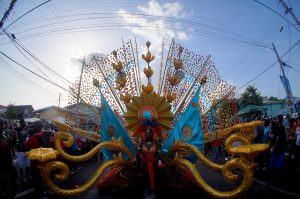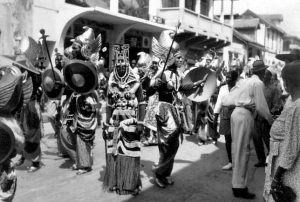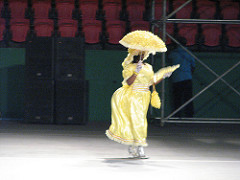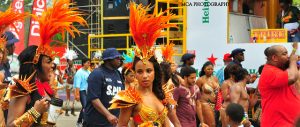
Synopsis
Playing Mas in Trinidadian Carnival involves the performances of many different masques, but the characters enacted are gendered in their representation. Tony Hall’s play Jean and Dinah gives voice to the women excluded from Carnival and serves as a response to female oppression in Trinidad and within this performance tradition.
Introduction

Playing mas in Carnival in Trinidad provides performers with a platform to raise social issues, enact their sense of self, and rebel against injustice. The Carnival tradition began in the 1800s with the French and British plantation owners who immigrated to Trinidad’s tradition of hosting masked balls to celebrate before the beginning of the Catholic holiday of Lent. Their slaves, meanwhile, carried out their own Carnival celebrations. In 1838, the slaves were emancipated and used Carnival as a mode of revolt. However, similarities in co between the Carnival of the elites and the Carnival of the working class emphasized the hybridity of the event. The defining characteristics of Carnival include playing mas, calypso, or the music of Carnival, and pan, or stickfighting accompanied by African percussion music, all of which originated with the traditions of the slaves. Carnival is thus rooted in the concept of using performance as rebellion, but oppression remains prevalent in the gendering of the traditional characters of Carnival. Major Sparrow’s 1956 calypso “Jean and Dinah” raises the issue of the suffering of Trinidadian women, but leaves their lived experience out of the picture. Tony Hall’s play Jean and Dinah, however, serves as a response to both Major Sparrow’s calypso and these repressive gender dynamics, giving the women of Carnival a voice to tell their story.
Playing Mas
Playing mas within Carnival allows performers to enact their sense of self by taking on another identity. “Mas” is a derivative of the root word “masque,” which refers to the masque bands that perform during Carnival. However, playing mas has become synonymous with life in Trinidad, meaning that the use of disguise to enact oneself through performance of the other is an essential way for Trinidadians to evoke their reality. Milla Cozart Riggio demonstrates how the socio-political background of Trinidad contributes to the importance of Mas, explaining that the dynamics between ruler and subject were never clear-cut. With the takeover of the British, the French Creole, and the Spanish, there was widespread conflict

among the ruling elite. Middle and underclasses classes were populated by a variety of people from different ethnic and racial backgrounds. In addition, there was interracial mating among the social classes, creating an even more complex social scene (Riggio 94). With regard to this historical background, Riggio asserts, “In this situation, carnival…emerged as the festive arena in which classes, races, and finally genders and even religions would most naturally mix with, resist, and finally accommodate each other. In a culture of multiple identities, to ‘play yuhself,’ as the carnival cliché suggests, may be best achieved in fantasies of the so-called ‘other”” (Riggio 94). For example, if each day a slave “plays” a slave while self-identifying as a Queen, on Carnival, a slave may “play” their true identity, making mas an essential a platform for the oppressed to fight back. Thus, playing Mas is central to both the history and present atmosphere in Trinidad as it continues to allow for the bridging and crossing boundaries.
Calypso
The calypso music of Carnival functions as both “good time music” and socio-political commentary. This type of music originated in west African slave communities that relied upon song to communicate and discuss current events, and though the origin of the word is not known, it is thought to be rooted in the west African word kaiso, meaning ‘bravo’ (Mason 21). In the eighteenth century, when French plantation owners and their slaves arrived in Trinidad, they brought these rhythms with them, and calypso music continued to develop in the early nineteenth century, influenced by both the Africans and the French. Thus, calypso carries the essential Carnival characteristic of hybridity. Accompanying calypso music is pan, or the martial art of stickfighting. Peter Mason explains how, after the emancipation of slavery in Trinidad, the slaves brought their tradition of stickfighting and the music connected to it to Carnival (Mason 23). The music of stickfighting is known as “kalinda,” and Mason significantly notes that kalinda music, though originally sung by both men and women, was taken over by men in the 1900s (Mason 22). Mason suggests that calypso took on its role as music for socio-political commentary in the 1940s and 1950s Trinidadian independence movement as a way to use song to critique the British government. He also argues, “Calypso is good time music, irreverent and coarse; that is why it is such an integral part of Carnival…proud tradition of calypso as a source of vulgarity. Sex has always been a major topic for calypsonians” (Mason 47). However, the fact that the majority of famous calypso singers are male means that women often appear in their songs as sexual objects, not forces giving voice to their opinions on the socio-political climate.
Ref. # 10
Mighty Sparrow and Jean and Dinah
Mighty Sparrow, born Slinger Francisco in 1935, is widely regarded as the greatest calypsonian in the history of calypso music. Mason argues, “He has everything the modern Calypsonian requires: a great voice, an eye for a catchy melody, sharp lyrics, charisma, and presentational skills and a finger on Trinidad’s pulse” (Mason 41). Furthermore, Sparrow’s significance extends from the musical realm into the political and the cultural: he aligned himself with the 1956 People’s National Movement in Trinidad under Dr. Eric Williams, and in the 1960s, he worked to bring Calypso out from under assumptions that it was little more than stickfighting music for the working class (Mason 26, 27). In 1956, he released his calypso “Jean and Dinah.” The song is about the effect the American soldiers had on Trinidad after leaving post-occupation, focusing on the women who resorted to prostitution with the native men, who they once rejected in favour of the “Yankees.” The calypso thus raises a gender issue long ignored in Trinidad, but David Lizardi Sierra argues that Mighty Sparrow actually contributed to the objectification of women in his song.
As sung in the video, the chorus to the song is written as follows:
So when you bounce up Jean and Dinah
Rosita and Clementina, round the corner posing
Bet your life is something they selling
And if you catch them
You can get em all for nothing
Don’t make no row, the yankees gone, Sparrow take over now.
Lizardi Sierra argues that Sparrow “wishes to stress the empowerment of men, while situating the social conditions driving women to prostitution as a mere backdrop. Sparrow’s calypso never considers the women’s perspective” (Lizardi Sierra 92). The lyrics “Sparrow take over now” especially align with Lizardi Sierra’s point about Sparrow’s participation in the push for male empowerment, and his reference to the women “posing” and “selling” references prostitution without incorporating their stories. However, Lizardi Sierra’s suggestion that “the calypsonian’s only concern is to avenge women’s rejection of the native men in the past” is perhaps too simplistic (Lizardi Sierra 92). While Mighty Sparrow fails to incorporate the viewpoint of Trinidadian women with regard to their struggles, he successfully raises an important issue for debate, proving calypso’s usefulness for commenting upon socio-political issues.
Tony Hall’s Jean and Dinah as a Response
Act I of Tony Hall’s play Jean and Dinah functions as a response to Mighty Sparrow’s calypso. Hall published the play in 2002, and, as it was inspired by Jean and Dinah of Major Sparrow’s calypso, the play imagines their lived experience. Act I is set in the 1990s, on “Jouvay morning,” or the dawn of Carnival Monday in Port-of-Spain, Trinidad, as Jean tries to coax her ailing friend Dinah into playing mas with her. In an essay about the play, Hall references his inspiration for the work, writing, “Sparrow’s keen observations of the gender politics sparked our attention, and to my mind the women had to reply” (Hall 165). Hall explains that he did not originally intend to write a play, but through conversations with Trinidadian actresses Susan Sandiford and Rhoma Spencer, who self-identify as “jamettes,” or retired prostitutes, he found that they “survive partly by infusing their own lives with the spirit of mas, [and so he] incorporated their story into a theatre totally derived from the carnival streets that in their essence belonged to Jean and Dinah” (Hall 166). This statement calls to mind Riggio’s point about mas as a way of life in Trinidad. Carnival is, in many ways, a theatrical tradition, exemplified by song, dance, acting, costuming, and more, and Hall thus found drama a useful lens through which to explore how the performance of mas can serve as a socio-political commentary on the experience of women in Trinidad.
Ref. # 8
In the above excerpt from a performance of the play at Lordstreet Theater Company in Trinidad and Tobago, Jean is attempting to lure Dinah out of bed. Jean remembers a man who used to be one of her customers, who would insult and spit on her but who was a “real good chantuelle,” according to Dinah, or stickfighter (Hall 6). Jean clarifies that he used the stick to hit her, beginning to sing a kalinda song accompanied with a stick, which persuades Dinah to dance with her (Hall 7). This is significant because, as Mason mentions, kalinda and stickfighting are traditionally conceived of as “male” arts, and Hall shows how women use the tradition to respond to both the injustice of being excluded from it and to comment upon the abuse they suffered as prostitutes. Jean then reminisces about her entrance into prostitution, led by a friend who brought her to a nightclub occupied by local men instead and how she made her first money this way. Dinah refuses to acknowledge that she, too, was a prostitute, but she remarks, “You know if you give them fellas a chance they will give you a bad name. They sing on you, just so. He and Little Sparrow. Next thing you know, people jumping to the tune of you on Carnival day” (Hall 15). Hall thus directly references Mighty Sparrow’s calypso, calling into question the idea of people dancing to a song about Trinidadian prostitutes without ever hearing their account. Thus, Hall uses theater to allow observers access into the stories of Jean and Dinah.
‘Traditional’ Characters of Carnival
Carnival involves performances of a variety of masque bands centered around a theme. Daniel J. Crowley’s article in the 1956 Carribbean Quarterly offers insight into the masques long considered ‘traditional.’ As Crowley explains, “The word ‘masque’ indicates that the band wears costumes based on a theme from history, current events, films, Carnival tradition, from the imagination, or from a combination of these” (Crowley 42). Some of the most relevant characters he addresses may be described as follows:

Negre Jardin and Batonnier: Originally, the ruling class would disguise themselves in blackface as their garden slaves, but over time, stick fighters appropriated the tradition as the costume for their performance.
Dame Lorine: At one time the march of the aristocrats, this tradition, too, has been appropriated over time as something of a mockery, with the working class dressing in the 18th century costumes of the aristocracy.
Jamet bands: Masked, retired prostitutes who collect money from bystanders on the streets as they dance, strut, and speak in seductive tones.
Fancy bands: Masques that are characterized by ‘pretty’ costumes, the most well-known being the “Baby Doll,” in which women, often jamettes, wear tiny babydoll dresses and bonnets and ask people on the streets for money to help raise their child.

Bad Behaviour Sailors: A mockery of the sailors who left Port-of-Spain, the men performing in this masque wear the white uniforms of the sailors and either enact or imitate extreme drunkenness.
Indians and other warriors: Wear costumes drawn from comic books, Western movies, magazines, and other forms of American media depicting cowboys and Indians. Another warrior, almost always performed by a man, is the Midnight Robber, who often wears a tight black costume and gives a long speech to threaten onlookers into giving him money.
Devils: dance frantically down the street and pretend to grab the clothing of people on the streets unless they supply them with money.
The Gendering of ‘Traditional’ Masques
The characters labelled ‘traditional’ have been gendered over the years, leaving women excluded from a male-dominated performance atmosphere. In the late 1900s, women began to enter into Carnival in ways they had not been previously been allowed, but in 1988 a collision began to take place between the “traditional male Carnival” and the Carnival which incorporates women. As a result, in Trinidad there was a movement to return to the roots of “traditional” Carnival. However, as Pamela Franco asserts, “The equating of the traditional with the authentic is problematic,” referring specifically to the prejudicial treatment of women via “the positing of femininity as a sign of inauthenticity, the evaluation of women’s mas through their reproductive role as mothers, and the interpretation of women’s mas style as a form of ‘emasculation’” (Franco 27). Discussing the aforementioned article by Crowley, Franco asserts that his conception of “traditional” masques relies upon a definition of “tradition” which prioritizes masculinity and posits femininity as abnormal. Of particular interest is her theory that Carnival functioned as a way for men to regain their masculinity after the emasculation of past political regimes, an hypothesis which aligns with Lizardi Sierra’s earlier argument that Mighty Sparrow’s calypso is motivated by a need to assert his manhood (Franco 37). Carnival masques such as the sailor, the Midnight Robber, the Devil, and the stickfighter are all male-dominated and glorify aggression, whereas ‘female’ masques such as the Jamet and the Baby Doll, create an image of a woman valuable only for her motherhood and mocked for her disgraceful sexuality. Critically, however, Franco notes that men are not held to the same standards of fatherhood, as exemplified by the Baby Doll who is left to the care of her mother, who must rely upon bystanders for help. Furthermore, the celebration of male aggression in characters like the Indian and Bad Behaviour Sailor is somewhat distressing in a society in which women are daily plagued by male violence (Franco 41, 42). Thus, the masques of Carnival that have long been considered ‘traditional’ repress women by pigeonholing them into stereotyped roles, a dynamic that seems to be at fault with the most important facet of Carnival: its ability to respond to oppression and injustice.
Jean and Dinah’s Gender Inversion
Tony Hall’s use of female characters to occupy archetypal mas roles in act two of Jean and Dinah shows how mas can be used as a gender inversion and a rebellion to the unjust gendered dynamics of Carnival. Where Act I was set in the 1990s, Act II of the play is set in the 1950s, revealing Jean and Dinah’s past through a variety of Carnival masques they enact. Tony Hall describes his performance model for the play, which he calls the “jouvay popular theatre process”: “This model assumes the existence of the traditional masquerade characters, not as specific historical figures but as archetypes of human behaviour defined within the evolving context of the survival systems of the emancipation tradition in Trinidad” (Hall 164). Thus, Hall uses the traditional characters described above, but through performance he shows how Jean and Dinah relate to certain characters, using their characteristics to stage their rebellion against injustice. In particular, Hall demonstrates how Jean and Dinah perform the Bad Behaviour Sailors, the Baby Doll and the Midnight Robber: “The sailor satirizes American imperialism, and the Baby Doll evokes gender politics, whereas the Midnight Robber seeks to avenge injustices done to his ancestors” (Hall 166). Hall shows how traditionally male masques can serve women as a rebellion against their exclusion from these roles and a way to tell their stories of oppression in Trinidad.
Ref. # 9
In this second video excerpt, Jean and Dinah are both dressed as Bad Behaviour Sailors, in the white uniforms of sailor men, and are both drinking heavily. Jean interacts with the audience, playing a sailor hitting on a woman. Describing a sailor she once served, Jean says, “He give me a blank focking cheque…You have to live. But that was because I did done pick his pocket” (Hall 50-51). The fact that she is a woman playing a man hitting on a woman serves as a critique of both the sailor men who used her sexuality for their own ends while denying her a place within the sailor masque, but she also reveals how she used her own female power to survive. The excerpt ends with the lyrics, “Brown skin gyal, stay home and mind baby. Ah going away in a sailing boat and if I don’t come back, stay home and mind baby,” a song which moves the action seamlessly into the next masque by revealing the impact American sailors had on women like Jean and Dinah when they impregnated them and then went to sea (Hall 53). Dinah re-appears onstage dressed as a Baby Doll, while Jean is asking after her father, who left for the American Navy. Dinah is asking bystanders for money to take care of her child, but she returns to reality in her adult voice to chide Jean for lying to her own child about her “Yankee” father and her inability to care for her child (Hall 54). The Baby Doll character thus allows Hall to raise the issue of the double standard placing pressure upon women as mothers and relieving men of their duties as fathers. In a third costume change, Dinah appears as the Midnight Robber from the underworld, stating, “I is Ruby Rab, Princess of the Dead, music maker of Pan and the Pan Man and if you don’t want to feel the full wrath of my tongue you better pay up!” (Hall, 68). Dinah, as the traditionally masculine Midnight Robber, emphasizes her power as a woman, a mother, a Trinidadian, and a fighter. By inverting traditionally male masques, Hall shows how Jean and Dinah not only make a place for women within Carnival, but also use the masques of Carnival in the spirit of Carnival: to expose and critique injustice.
Women in Carnival Today

Today, women are taking back Carnival in their own style. Men continue to outnumber women within the ‘traditional’ masques, but more than eighty percent of Carnival performers playing mas are women. Riggio explains, “Empowered by the beauty and sexuality made visible by the bikini costumes that are the bane of carnival purists and traditionalists, women who decades ago might have taken refuge in a decorated lorry now mingle with others on the street, proudly displaying bodies often honed for the occasion” (Riggio 107). As shown in the image, women take pride in showing off their female sexuality in costumes once called disgraceful. Additionally, Franco suggests that the “overall aesthetic of the festival” has also changed: “In performance, for example, women prefer the highly sexualized dance, wining, instead of the traditional characterization or playing someone other than themselves, a hallmark of performance theory and masquerade systems” (Franco 25). Women are rebelling against the masques that seek to exclude them, celebrating their femininity instead of disguising it. However, Franco cautions that “we need a new paradigm to evaluate the contemporary mas; one that would allow for a more panoramic and democratic view of the festival; one that would value the contributions of all participants” (Franco 44). Rather than focusing on the way in which women overcame their exclusion by creating their own traditions, it is important to strive to evaluate Carnival mas through an all-inclusive lens, creating a place inside Carnival where women feel supported and respected.
Conclusion
Tony Hall’s play Jean and Dinah may function as a first step towards a more inclusive Carnival. Through the staging of Jean and Dinah’s story, the women are able to speak back to their representation in Major Sparrow’s song in their own voices and through the inversion of gendered carnival masques, providing a poignant example of how theater can help decolonise Carnival mas even further. Hall empowers the women of Carnival by allowing them to tell their own stories of oppression within Trinidadian Carnival mas through the performance of Trinidadian Carnival mas, seeking to reverse unequal gender dynamics. Thus, the characteristic emancipatory roots of Carnival make the performance tradition especially conducive to Hall’s dramatic rendition.

Works Cited
Literature
Crowley, Daniel J. “The Traditional Masques of Carnival,” in Trinidad Carnival, A
Republication of the Caribbean Quarterly Trinidad Carnival Issue, vol 4., no. 3 & 4 of
1956 (Paria Publishing Co. Ltd., 1988), pp. 42-98.
Franco, Pamela R. “The Invention of Traditional Mas and the Politics of Gender” in Garth L.
Green and Philip W. Scher (eds.), Trinidad Carnival: The Cultural Politics of a
Transnational Festival (Bloomington: Indiana University Press, 2007), pp. 25-48.
Hall, Tony. Jean and Dinah…Who Have Been Locked Away in a World Famous Calypso Since
1956 Speak Their Minds Publicly. Port of Spain: The Lordstreet Theatre Company, 2001. Print.
Hall, Tony. “The Jouvay Popular Theatre Process: From the Street to the Stage” in Milla Cozart
Riggio (ed.), Culture in Action – The Trinidad Experience (New York: Routledge, 2004),
162-167.
Martin, Carol. “Trinidad Carnival Glossary” in Milla Cozart Riggio (ed.), Culture in Action –
The Trinidad Experience (New York: Routledge, 2004), pp. 283-295.
Mason, Peter. “Kaiso!” in Bacchanal! The Carnival Culture of Trinidad (Philadelphia: Temple
University Press, 1998), pp. 17-52.
Riggio, Milla Cozart. “‘Play Mas – Play Me, Play We: Introduction to Part II” in Milla Cozart
Riggio (ed.), Culture in Action – The Trinidad Experience (New York: Routledge, 2004),
93-109.
Images
1. Aberdeen, Marc. DSC_3204. 8 March 2011. Flickr, https://flic.kr/p/9ptHGb. Accessed 16 AprilLicensed under https://creativecommons.org/licenses/by-nd/2.0/legalcode.
2. anax44. Carnival Tuesday. 4 March 2014. Flickr, https://flic.kr/p/kKc9Rk. Accessed 16 April
- Licensed under https://creativecommons.org/licenses/by-sa/2.0/legalcode.
3. Carnaval.com Studios. Carnival-sat-23. 17 February 2007. Flickr, https://flic.kr/p/5D1WUe.
Accessed 16 April 2018. Licensed under https://creativecommons.org/licenses/by/2.0/legalcode.
4. Carnaval.com Studios. Old-Mas-TnT-32. 14 February 2007. Flickr, https://flic.kr/p/5D17uE.
Accessed 16 April 2018. Licensed under https://creativecommons.org/licenses/by/2.0/legalcode.
5. Carnaval.com Studios. Old-Mas-TnT-52. 14 February 2007. Flickr, https://flic.kr/p/5CVLzD.
Accessed 16 April 2018. Licensed under https://creativecommons.org/licenses/by/2.0/legalcode.
6. Hill, Dr. Ted. Carnival Band. 1950. Wikimedia Commons,
https://commons.wikimedia.org/wiki/File:Carnival_band_2.jpg. Accessed 16 April 2018. Licensed under https://creativecommons.org/licenses/by-sa/2.5/legalcode.
7. Jean Marc/Jo BeLo/ Jhon-John. Carnival Masqueraders in Trinidad and Tobago. 9 March 2006.
Wikimedia Commons, https://commons.wikimedia.org/wiki/File:Orange_Carnival_Masqueraders_in_Trinidad.jpg. Accessed 16 April 2018. Licensed under https://creativecommons.org/licenses/by/2.0/legalcode
Videos
8. “Jean and Dinah…Speak Their Minds Publicly by Tony Hall (Excerpt # 2).” Youtube, uploaded
by Lordstreet Theatre (Jouvay Digital 2.30), 29 August 2007,
9. “Jean and Dinah…Speak Their Minds Publicly by Tony Hall (Excerpt # 4).” Youtube, uploaded
by Lordstreet Theatre (Jouvay Digital 2.30), 29 August 2007,
https://youtu.be/TgxLAVj6LRo.
10. “Mighty Sparrow- Jean and Dinah.” Youtube, uploaded by Canchozl, 14 Septebmer 2008,